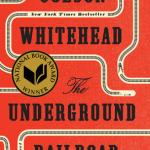The Underground Railroad

The Underground Railroad
A Novel
Colson Whitehead
Doubleday
ISBN 9780385542364
Previously nominated for the Pulitzer Prize and the recipient of a Guggenheim fellowship and a MacArthur “genius” grant, Colson Whitehead has now been nominated for a National Book Award for his latest novel, The Underground Railroad, itself already selected as an Oprah’s Book Club pick for 2016. Whitehead is also the author of John Henry Days, The Intuitionist and The Colossus of New York, among others, which explore questions of race, masculinity and identity.
In The Underground Railroad, Whitehead continues his excavation of the African-American experience, this time focusing on the nadir of racial violence against blacks in America: slavery. Whitehead’s hero is Cora, a woman who risks her life to escape a violent master on a Georgia plantation and is dogged by a persistent slave catcher determined to drag her back into slavery.
Whitehead’s historical research is detailed and accurate: Here is the systematic rape of black women to breed more slaves; the scientific experiments done on escaped slaves without their consent, involving sterilization and syphilis infection in government-run hospitals; and the willful, violent destruction of a prosperous community of black free men and women by white violence in an echo of the real-life destruction of Black Wall Street. Here, too, embedded within the text, are advertisements posted by white owners for runaway slaves, eerie and horrifying found objects of history acting like grave markers in a cemetery.
As in Yaa Gyasi’s Homegoing and Alex Haley’s Roots, Whitehead begins his slave narrative in Africa. We enter the story with Cora’s African grandmother Ajarry as she is stolen from her homeland. In elegant, sparse language, Whitehead captures the horror of the kidnapped Africans—“The survivors from her village told her that when her father couldn’t keep the pace of the long march, the slavers stove in his head and left his body by the trail”—and the trauma of the ocean crossing to America: “Chained head to toe, head to toe, in exponential misery.”
At the slave auction, there is the white man who “pinched her breasts to see if she was in flower” before Ajarry was bought and “branded, not for the first or last time, and fettered to the rest of the day’s acquisitions.” Ajarry was sold again and again, for work and for breeding. This, of course, is based on historical record.
Yet throughout the misery, Ajarry’s experiences raise the idea of legacy rebuilding—the nature of family. Ajarry never saw her siblings or other relatives after being kidnapped and sold into slavery, but Ajarry created a new line, beginning with herself. Cora is the child of Ajarry’s daughter Mabel, who is the only one of Ajarry’s five children to live past 10 and survive both disease and the physical violence of their white slave owners. In Mabel and in Cora, Ajarry instilled all that she knew.
Despite the best efforts of her mother and grandmother to care for her, Cora grows up knowing only the many different types of violence that permeate slavery on a cotton plantation. Food scarcity, beatings, poor shelter and lack of heat in the winter. No time off or medical care. Gang rape. Abuse from slave masters and from the slaves ordered to do their bidding. All of these things, we know, again are in the historical record.
But the great tragedy of Cora’s life is her abandonment by her mother. Here are the layers of complexity and nuance that add depth to character and humanize Cora’s anger with Mabel. When Cora was just 11, her mother ran away and left her behind, becoming the only slave to ever successfully escape the Randall plantation.
The mystery of Mabel’s disappearance haunts the narrative. It could be her mother’s escape that prompts Cora to consider the possibility of her own escape when approached by Cesar, a new slave on the plantation. “I’m going back north,” Cesar says simply. “I want you to come.”
At first Cora is hesitant to escape, but as the violence on the plantation intensifies, she warms to Cesar’s plan. Quite simply, the plantation had been run by two brothers, James and Terrance Randall: “James was as ruthless and brutal as any white man, but he was the portrait of moderation compared to his younger brother.” With James’ death, Terrance was left in full control of the plantation.
Cora and Cesar’s escape is fraught with peril and fear, of course, but they persevere. “Every mile between her and the plantation was a victory,” Cora thinks. What is fascinating is that here, the Underground Railroad is, quite literally, an underground railroad. After Cora and Cesar descend into the tunnel, the train arrives: “The locomotive was black, an ungainly contraption led by the triangular snout of the cowcatcher.”
Each stage of the underground railroad passes them through a different state: from Georgia to South Carolina and on to North Carolina, where Cora is captured by slave catchers and desperately searches for another chance at freedom.
Whitehead has crafted a realistic and unalloyed depiction of the savagery of slave owners and slavery. A slave who attempts escape is kept in the stocks and whipped for three days, then doused with oil and roasted alive after his “manhood had been cut off on the first day, stuffed in his mouth, and sewn in.”
In The Underground Railroad, Whitehead carefully articulates the psychology of the slave: The dream of freedom that must be continually repressed to survive life in bondage. The desire to have some agency—no matter how little—over one’s own body, one’s own life. The constant fear and constant violence. The layers of institutional racial violence, both in the North and South. The struggle to truly find safety and to be free. A haunting, powerful and necessary read.
Hope Wabuke is a Southern California-based writer and a contributing editor at The Root.
